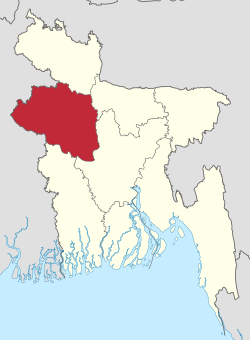Exploring Rajshahi Division: Bangladesh’s Northwest Jewel
Rajshahi Division, located in the northwest region of Bangladesh, captures the heart with its lush landscapes and vibrant culture. The picturesque banks of the Ganges River, adorned with green fields and bustling markets, create a unique charm that draws visitors from near and far. Rich in history and tradition, Rajshahi offers something for everyone, be it travelers seeking adventure or investors looking for new opportunities. This region is a captivating blend of natural beauty, rich history, and vibrant culture, making it a compelling destination.
Ancient Heritage: Exploring Historical Sites and Their Significance
Rajshahi boasts a rich historical backdrop, showcasing sites that tell stories from centuries ago. The ruins of Puthia Temple Complex, known for its beautiful terracotta architecture, reflect the architectural skill of the Pala dynasty. Another significant site is the Varendra Research Museum, home to thousands of artifacts that uncover Bangladesh’s past. History buffs can learn about the ancient Buddhist Vihara at Paharpur, a UNESCO World Heritage Site, which once served as a learning center and dates back to the 8th century.
Cultural Traditions: Focus on Local Festivals, Folk Arts, and Unique Cultural Practices
Cultural traditions thrive in Rajshahi. The celebration of Nabanna, marking the new rice harvest, showcases the region’s agrarian roots. Folk music and dance add vibrancy to festivals, with Baul musicians often seen performing in the countryside. In 2019, cultural tourism in Bangladesh rose by 20%, with Rajshahi’s unique offerings drawing visitors interested in experiencing authentic local culture.





The Role of Rajshahi in Bangladesh’s History
Rajshahi has played an integral role in Bangladesh’s history, particularly during the Language Movement of the 1950s and the Liberation War of 1971. The city served as a hub for activists advocating for linguistic rights. Educational institutions like Rajshahi University have been at the forefront of progressive movements, contributing significantly to social change. In 1971, Rajshahi faced significant conflict, marking its importance in national liberation efforts.
The Heart of Agriculture: Rajshahi’s Economic Landscape
Agriculture and Its Significance
Agriculture serves as the backbone of Rajshahi’s economy, with products like mangoes, silk, and rice dominating the landscape. The division contributes approximately 20% to Bangladesh’s annual rice production. In 2022, Rajshahi produced about 1.2 million tons of mangoes, earning a reputation for its delicious varieties like Langra and Himsagar.
Challenges and Opportunities in Agriculture
However, agriculture faces challenges such as climate change and soil degradation. Farmers often struggle with unpredictable weather patterns. Modernization and technology offer promising opportunities to overcome these issues. Initiatives like introducing drought-resistant crops and smart irrigation systems can significantly boost productivity. Experts emphasize the need for adopting climate-smart agriculture to ensure sustainability.
Beyond Agriculture: Explore Other Economic Sectors
Beyond agriculture, Rajshahi is home to textile and silk industries, contributing to the local economy. The city has established itself as a center for quality silk production, making a mark in both local and international markets. Recent statistics show that the textile sector accounts for around 10% of the national GDP, highlighting its importance.
Natural Beauty and Tourist Attractions
Scenic Wonders
Rajshahi is blessed with breathtaking natural beauty. The Ganges River not only provides scenic views but also enhances local livelihoods. The landscape features lush green fields, picturesque hills, and a stunning array of flora and fauna. The Rani Bill Wildlife Sanctuary is a notable destination for nature lovers, showcasing a rich biodiversity.
Popular Tourist Destinations
Key tourist spots include the historic Puthia Temple Complex and the serene Padma River. The city’s parks, like the Rajshahi Shaheed Minar Park, offer tranquil environments for relaxation. Travelers can also explore local markets to experience the vibrant culture firsthand. Visitors should try local delicacies like Pati Shapta, a rice flour crepe filled with coconut.
Promoting Sustainable Tourism
Sustainable tourism practices are essential for protecting Rajshahi’s natural and cultural heritage. Eco-friendly options include visiting local farms and participating in community-based tourism initiatives. Travelers are encouraged to respect local traditions and support small businesses to ensure that tourism benefits the local community.
Infrastructure and Development
Transportation and Connectivity
Rajshahi’s infrastructure is evolving, with improvements in transportation and communication networks. The city is well-connected by road and rail, facilitating easier travel for locals and tourists. As of 2023, the government has invested over $50 million in upgrading roadways to enhance connectivity to neighboring districts.
Urban Development and Challenges
Urbanization presents both challenges and opportunities in Rajshahi. While the city has seen growth in various sectors, infrastructure must keep pace. Recent urban development projects have focused on creating affordable housing and improving public transportation systems. The Rajshahi City Corporation is working on initiatives to make the city more livable.
Government Initiatives and Future Plans
The government is focused on enhancing infrastructure to foster economic growth. Projects include expanding the airport and improving public transport routes. These initiatives aim to attract more visitors and investment, shaping a brighter economic future for Rajshahi.
The People of Rajshahi: Demographics and Society
Population Distribution and Demographics
Rajshahi Division has a diverse population of approximately 2.5 million people. The demographic mix includes various ethnicities and religious backgrounds, contributing to a rich cultural tapestry.
Social Fabric and Community Life
Community life in Rajshahi is vibrant and communal. Traditional practices such as tea gatherings and storytelling promote social bonds. Local markets buzz with activity, reflecting the community’s spirit and resilience.
Education and Healthcare
Education and healthcare facilities are improving in Rajshahi. The literacy rate stands at around 73%, slightly higher than the national average. Medical facilities have expanded, though challenges remain, particularly in rural areas. Recent investments aim to enhance healthcare accessibility for all citizens.
From Wikipedia, the free encyclopedia

| Rajshahi Division
রাজশাহী বিভাগ |
|
| Division of Bangladesh | |
| Clockwise from the top: Somapura Mahavihara, Choto Sona Mosque, Jamuna Bridge, Rooppur Nuclear Power Plant & Hardinge Bridge, Uttara Ganabhaban and Gokul Medh |
|
| Nickname:
Land of Zamindars |
|
| Rajshahi Division in BangladeshDistricts of Rajshahi DivisionShow all | |
| Coordinates: 25°00′N 89°00′E | |
| Country | Bangladesh |
| Established | 1829 |
| Capital and largest city |
Rajshahi |
| Government | |
| • Divisional Commissioner | Dr. Dewan Muhammad Humayun Kabir[1] |
| • Deputy Inspector General (DIG) | Md. Alamgir Rahman |
| • Parliamentary constituency | Jatiya Sangsad (39 seats) |
| Area | |
| • Division of Bangladesh | 18,174.4 km2 (7,017.2 sq mi) |
| Population | |
| • Division of Bangladesh | 20,353,116 (Enumerated) |
| • Urban | 4,840,396 |
| • Rural | 15,511,404 |
| • Metro | 553,241 |
| • Adjusted Population[2] | 20,794,019 |
| Languages | |
| • Official language | Bengali[3] |
| • Indigenous minority languages | show
List[4] |
| Time zone | UTC+6 (BST) |
| ISO 3166 code | BD-E |
| HDI (2017) | 0.602[5] medium |
| Notable sport teams | Rajshahi Kings, Rajshahi Division |
| Website | rajshahidiv.gov.bd |
Rajshahi Division (Bengali: রাজশাহী বিভাগ) is one of the eight first-level administrative divisions of Bangladesh. It has an area of 18,174.4 square kilometres (7,017.2 sq mi) and a population at the 2022 Census of 20,353,119. Rajshahi Division consists of 8 districts, 70 Upazilas (the next lower administrative tier) and 1,092 Unions (the lowest administrative tier).
The region has historically been dominated by various feudal Rajas, Maharajas and Zamindars. Formerly comprising 16 districts, a new division (Rangpur Division) was formed with the 8 northern districts of the old Rajshahi Division from early 2010.
Etymology and names
The Rajshahi Division is named after Rajshahi District. Dominated by various feudal Rajas, Maharajas and Zamindars of mixed origins throughout history, the name is a compound of the words Raj and Shahi, both of which can be translated into reign or kingdom. Archaic spellings in the English language also included Rajeshae.
History
Rajshahi Division was created in 1829 by the British Government. It was the largest division in Bengal Province. During partition of Bengal in 1947, the division was partitioned in two halves. The eastern half remained as Rajshahi division, while its western half became Jalpaiguri division of West Bengal, India. In January 2010 the Rangpur Division split out from Rajshahi division.
Demographics
| Religion in Rajshahi division (2022)[2] | ||
| Religion | Percent | |
| Muslims | 93.71% | |
| Hindus | 5.70% | |
| Christians | 0.41% | |
| Others | 0.18% | |
At the time of the 2022 Bangladeshi census, Rajshahi division had a population of 20,351,864. Muslims are 19,071,092 which is 93.71% of the population, while Hindus are 1,159,152 which is 5.70% of the population. Other religions (almost entirely Christianity and indigenous faiths) are only 0.59% of the population and are mainly found among the ethnic minorities.[2]
Districts
Education
The major educational institutes in Rajshahi are:
- University of Rajshahi(RU)
- Rajshahi Polytechnic Institute(RPI)
- Rajshahi University of Engineering and Technology(RUET)
- Rajshahi Medical University ( RMC)
- North Bengal International University(NBIU)
- Rajshahi Medical College(RMC)
- Bangladesh Army University of Engineering & Technology
- Rajshahi Science & Technology University[9]
- Shaheed Ziaur Rahman Medical College, Bogra
- Joypurhat Girls Cadet College, Joypurhat
- Rajshahi College
- Rajshahi Govt. City College, Rajshahi
- New Govt. Degree College, Rajshahi
- Rajshahi Cadet College
- Azizul Haque College, Bogra
- Bogra Zilla school
- Pabna Zilla school
- Pabna Cadet College
- Pabna Textile Engineering College
- Edward College, Pabna
- Pabna University of Science and Technology
- Pabna Medical College, Pabna
- Joypurhat Government College
- Shaheed M. Monsur Ali Medical College, Sirajganj
- Government Laboratory High School Rajshahi
- Rajshahi Collegiate School(RCS), Rajshahi
- Naogaon K.D. Government High School,Naogaon
The University of Rajshahi (established 1953) is the second largest university of Bangladesh with around 50 disciplines and 6 institutes. Rajshahi Collegiate School (established in 1828) is one of the oldest school in the country and Indian sub-continent which became again the best school in Bangladesh in 2018.
Conclusion
Rajshahi Division stands out with its unique blend of natural beauty, rich history, and vibrant culture. From its agricultural prowess to its historical significance, this region offers endless opportunities for growth and exploration. As a destination and an economic hub, Rajshahi is poised for a promising future. Whether you are visiting for leisure or investment, the charm and warmth of Rajshahi will leave a lasting impression. Embrace the allure of this northwest jewel in Bangladesh and be part of its unfolding story.





